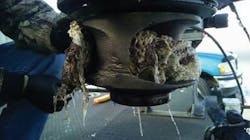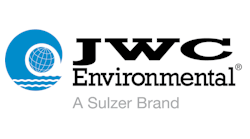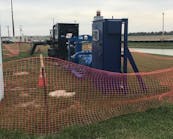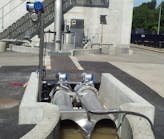Regardless of the haul route, commercial drivers across America have come to rely on Pilot Flying J truck stops as a comfortable one-stop respite during the long hours between their destinations. Customers can grab a hot meal, do their laundry, use the business center or even visit an urgent care clinic if needed. Since the merger of Pilot TravelCenters LLC and Flying J Inc. in 2010, the new company has expanded its network to more than 550 interstate travel centers, all touting superior customer service and enhanced offerings for trucking companies, professional drivers, recreational vehicle drivers and traveling motorists.
Overwhelmed Municipal Sewers
Due to the enormous customer volume each truck stop experiences on a daily basis – well into the thousands at some locations – Pilot Flying J project engineers are constantly evaluating each truck stop’s wastewater handling needs.
“We’ve seen articles of clothing, soup cans, golf balls, boots and all sorts of debris appear in our waste lines, meaning someone was trying to flush those things down a toilet,” said David Grueser, project manager at Pilot Flying J.
This influx of tough debris flood into local lift stations, which in many cases are ill-equipped to deal with such a large volume of trash.
“Oftentimes, our truck stops are in smaller towns that don’t have the same sewage processing capabilities as larger city locations,” Grueser said.
A group of project engineers at Pilot Flying J began searching for a solution to this problem that was cost-effective, reliable and, most importantly, a one-size-fits-all answer for the variety of locations.
“Instead of each engineer across the country specifying a different solution, we decided to find a robust grinder system we could use regardless of situation,” Grueser said.
Their search led them to connect with the technical sales staff at JWC Environmental. JWC’s team worked closely with the Pilot Flying J project engineering and construction management teams to find a solution that would handle the tough debris from these truck stops across the numerous wastewater system configurations.
Streamlined Solution
Pilot Flying J settled on the Monster Industrial Manhole, which makes installing a wastewater grinder within a sewage line hassle-free. The prefabricated manhole, with a 3-HYDRO-C grinder designed in, fits easily into a gravity-fed sewer line without major civil works.
“We love the consistent performance of the Monster Industrial Manhole design and how reliable it is,” Grueser said. “And, between the fast turnaround time and ease of installation, we feel we found the perfect solution.”
Grueser also commended JWC for being able to adapt quickly when changes arose.
“JWC Environmental has worked with us even when we encountered design challenges,” he said. “One example was in Marion, N.C., when we realized we needed to reconfigure the placement of the 3-HYDRO-C grinder within the manhole but meet the construction schedule. They were able to coordinate the changes, expedited shipment and it all arrived in time.”
Installation Benefits
Dynamis Inc. of Knoxville, Tenn., partners with Pilot Flying J to provide wastewater treatment support for installations.
“Because of the growth of the company, Pilot Flying J has built their own truck stops as well as purchased other independent truck stops,” said Andrew West, Dynamis Inc. environmental specialist and field technician. “There have been a lot of ‘cooks in the kitchen’ with how systems have been designed and how they’ve been set up. In the waste-stream department, they may have 15 different sites, all with different lift stations, different design layouts and even different set-ups. They’ve been factoring the Monster Industrial Manholes into new facilities as well as rehabbing facilities since we’ve had good luck with them in different locations.”
Because of the nature of the waste – which can include plastics, wipes and even denim clothing – West said, “The 3-HYDRO-C grinder chews through them like paper, and it’s good to know that it can handle the waste.”
Compared to the cost of other solutions, West also said that the Monster manhole grinder was the most cost-effective fix for their needs. Larger pumps may resolve some of the issues but would lead to other construction and capital costs.
“The footprint of the Monster Industrial Manhole is smaller, and it’s an easier install compared to putting in a septic tank, a fall-out tank or a large lift station,” he said. “With the JWC unit, everything is done in one package – we just dig the hole and attach the power leads, pipe it in and it’s good to go.”
Eliminating the Onsite Lift Station
Another benefit to the installation of a Monster Industrial Manhole, according to West, is the fact that it can meet mandated wastewater treatment requirements for a local municipality.
“A local municipality may say that heavy solids loading from the truck stop is affecting municipal lift stations further down the line or overloading the sewer leading to the wastewater treatment plant,” he said. “In that case, the municipality may request or mandate some type of solids treatment for a specific location. We prefer the Monster Industrial Manhole because it’s an easier setup. We can locate a suitable spot on the line, drop a hole there, cut the line and install the Monster manhole grinder.”
According to West, the biggest cost savings with the Monster Industrial Manhole comes from reducing unscheduled maintenance.
“With a lot of lift stations, quarterly inspection and cleanout of solids buildup is required, and it takes a lot of specialized knowledge to troubleshoot,” he said. “The 3-HYDRO-C grinder is a much easier system to maintain on the small scale. I don’t recommend that you set it and forget it, but checking on it weekly is all that’s needed and can be done by onsite maintenance staff. Just lift up the manhole and see that the grinder is turning.”
The partnership between JWC Environmental and Pilot Flying J has provided a consistent pump protection solution for the wide range of Pilot Flying J locations while also allowing it to be a good corporate citizen within the municipal sewer network.



